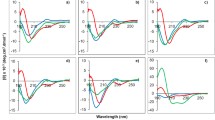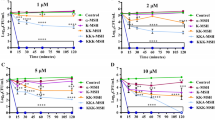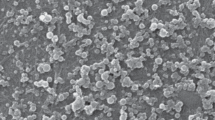Abstract
Introduction of liposomes into target cells is important for drug delivery systems. For this purpose, the surface of the liposome is equipped with ligand peptides, which may bind to specific receptors on the cell membrane. An artificial novel lipopeptide (MSH-C4A2) containing the α-melanocyte-stimulating hormone (α-MSH) sequence and two long alkyl chains was designed and synthesized, and the liposome, composed of egg phosphatidylcholine (EPC) and MSH-C4A2, was prepared. The stability of the liposome was estimated by measuring calcein leakage from the liposome inner phase. The stability of the liposome decreased upon addition of MSH-A4C2, which seemed to be attributable to the amphiphilic property of the peptide moiety (α-MSH) of MSH-A2C4. The stability was, however, recovered fairly well upon addition of cholesterol (Ch) or phosphatidylglycerol (PG). It was concluded therefore that the ternary system, MSH-C4A2/Ch/EPC or MSH-C4A2/PG/EPC, is suitable for preparing the functional liposome.
Similar content being viewed by others
Abbreviations
- Ch:
-
5-cholesten-3β-ol (cholesterol)
- DDS:
-
drug delivery system
- DMAP:
-
4-dimethylaminopyridine
- DMF:
-
dimethylformamide
- EPC:
-
egg phosphatidylcholine hydrogenated
- FAB:
-
fast-atom bombardment
- Fmoc:
-
N-α-9-fluorenylmethoxycarbonyl
- HOBt:
-
1-hydroxybenzotriazole
- MS:
-
mass spectrometry
- α-MSH:
-
α-melanocyte-stimulating hormone
- NMR:
-
nuclear magnetic resonance
- PG:
-
1,2-dipalmitoyl-sn-glycero-3-[phospho-rac-(1-glycerol)] sodium salt (phosphatidylglycerol)
- TBTU:
-
2-(1H-benzotriazole-1-yl)-1,1,3,3-tetramethyluronium tetrafluoroborate
- TFA:
-
trifluoroacetic acid
- WSCI:
-
1-ethyl-3-(3-dimethylaminopropyl)-carbodiimide hydrochloride
References
Connor, J., and Huang, L. (1986) pH-Sensitive Immunoliposomes as an Efficient and Target-Specific Carrier for Antitumor Drugs, Cancer Res. 46, 3431–3435.
Briscoe, P., Caniggia, I., Graves, A., Benson, B., Huang, L., Tanswell, A.K., and Freeman, B.A. (1995) Delivery of Superoxide Dismutase to Pulmonary Epithelium via pH-Sensitive Liposomes, Am. J. Physiol. 268, L374–380.
Ropert, C., Malvy, C., and Couvreur, P. (1993) Inhibition of the Friend Retrovirus by Antisense Oligonucleotides Encapsulated in Liposomes: Mechanism of Action, Pharm. Res. 10, 1427–1433.
Holmberg, E.G., Reuer, Q.R., Geisert, E.E., and Owens, J.L. (1994) Delivery of Plasmid DNA to Glial Cells Using pH-Sensitive Immunoliposomes, Biochem. Biophys. Res. Commun. 201, 888–893.
Higashi, N., and Sunamoto, J. (1995) Endocytosis of Poly-(ethylene oxide)-Modified Liposome by Human Lymphoblastoid Cells, Biochim. Biophys. Acta 1243, 386–392.
Varga, J.M., Asato, N., Lande, S., and Lerner, A.B. (1997) Melanotropin-Daunomycin Conjugate Shows Receptor-Mediated Cytotoxicity in Cultured Murine Melanoma Cells, Nature 267, 56–58.
Gabizon, A., Dagan, A., Goren, D., Barenholz, Y., and Fuks, Z. (1982) Liposomes as in vivo Carriers of Adriamycin: Reduced Cardiac Uptake and Preserved Antitumor Activity in Mice, Cancer Res. 42, 4734–4739.
Hauser, H. (1984) Some Aspects of the Phase Behaviour of Charged Lipids, Biochim. Biophys. Acta 772, 37–50.
Szoka, F., and Papahadjopoulos, D. (1978) Procedure for Preparation of Liposomes with Large Internal Aqueous Space and High Capture by Reverse-Phase Evaporation, Proc. Natl. Acad. Sci. USA 75, 4194–4198.
Miyazawa, T., Otomatsu, T., Fukui, Y., Yamada, T., and Kuwata, S. (1988) Racemization-Free and Efficient Peptide Synthesis by the Carbodiimide Method Using 1-Hydroxybenzotriazole and Copper(II) Chloride Simultaneously as Additives, J. Chem. Soc., Chem. Commun., 419–420.
Fields, C.G., Lloyd, D.H., Macdonald, R.L., Otteson, K.M., and Noble, R.L. (1991) HBTU Activation for Automated Fmoc Solid-Phase Peptide Synthesis, Pept. Res. 4, 95–101.
Gavin, E.R., and Simpson, R.J. (1992) Automated Solid-Phase Peptide Synthesis: Use of 2-(1H-Benzotriazol-1-yl)-1,1,3,3,-tetramethyluronium Tetrafluoroborate for Coupling of tert-Butyloxycarbonyl Amino Acids, Anal. Biochem. 200, 301–309.
Kappeler, H., and Schwyzer, R. (1961) Die Synthese eines Tetracosapeptides mit der Aminosauresequenz eines hochaktiven Abbauproduktes des β-Corticotropins (ACTH) aus Schweinehypophysen, Helvet. Chim. Acta 44, 1136–1141.
Carpino, L.A., and Han, G.Y. (1970) The 9-Fluorenylmethoxy-carbonyl Function, A New Base-Sensitive Amino-Protecting Group, J. Am. Chem. Soc. 92, 5748–5749.
Sheehan, J.C., Cruickshank, P.A., and Boshart, G.L. (1961) A Convenient Synthesis of Water-Soluble Carbodiimides, J. Org. Chem. 26, 2525–2528.
Annette, G., Sickinger, B., Dürr, H., and Jung, G. (1991) Semiautomated T-Bag Peptide Synthesis Using 9-Fluorenyl-methoxycarbonyl Strategy and Benzotriazol-1-yl-tetramethyluronium Tetrafluoroborate Activation, Pept. Res. 4, 88–94.
Miyoshi, M., Kimura, T., and Sakakibara, S. (1970) The Synthesis of a Series of N-t-Amyloxycarbonyl-oligo-l-proline, Bull. Chem. Soc. Jpn. 43, 2941–2944.
Fields, G.B., and Noble, R.L. (1990) Solid Phase Peptide Synthesis Utilizing 9-Fluorenylmethoxycarbonyl Amino Acid, Int. J. Pept. Protein Res. 35, 161–214.
Pick, U. (1986) Liposomes with a Large Trapping Capacity Prepared by Freezing and Thawing of Sonicated Phospholipid Mixtures, Arch. Biochem. Biophys. 212, 186–194.
Lin, B.Z., Yin, C.C., and Hauser, H. (1993) The Effect of Positive and Negative pH-Gradients on the Stability of Small Unilamellar Vesicles of Negatively Charged Phospholipids, Biochim. Biophys. Acta 1147, 237–244.
Wu, X., Lee, K.H., and Li, Q.T. (1996) Stability and pH Sensitivity of Sulfatide-Containing Phosphatidylethanolamine Small Unilamellar Vesicles, Biochim. Biophys. Acta 1284, 13–19.
Mabrey, S., Mateo, P.L., and Sturtevant, J.M. (1978) High-Sensitive Scanning Calorimetric Study of Mixtures of Cholesterol with Dimyristoyl- and Dipalmitoylphosphatidylcholines, Biochemistry 17, 2464–2468.
Lecuyer, H., and Dervichian, D.G. (1969) Structure of Aqueous Mixtures of Lecithin and Cholesterol, J. Mol. Biol. 45, 39–57.
Op Den Kamp, J.A.F., Bonsen, P.P.M. and van Deenen, L.L.M. (1969) Structural Investigations on Glucosaminyl Phosphatidyl-glycerol from Bacillus megaterium, Biochim. Biophys. Acta 176, 298–305.
Brasseur, R., Pillot, T., Lins, L., Vanderkerckhove, J., and Rosseneu, M. (1997) Peptide in Membranes: Tipping the Balance of Membrane Stability, TIBS 22, 167–171.
Hubbell, W.L., and McConnell, H.M. (1971) Molecular Motion in Spin-Labeled Phospholipids and Membranes, J. Am. Chem. Soc. 92, 314–326.
McElhaney, R.N., de Gier, J., and van Deenen, L.L.M. (1970) The Effect of Alterations in Fatty Acid Composition and Cholesterol Content on the Permeability of Mycoplasma laidlawaii B Cells and Derived Liposomes, Biochim. Biophys. Acta 219, 245–247.
Author information
Authors and Affiliations
Corresponding author
About this article
Cite this article
Ogawa, Y., Kawahara, H., Yagi, N. et al. Synthesis of a novel lipopeptide with α-melanocyte-stimulating hormone peptide ligand and its effect on liposome stability. Lipids 34, 387–394 (1999). https://doi.org/10.1007/s11745-999-0377-5
Received:
Revised:
Accepted:
Issue Date:
DOI: https://doi.org/10.1007/s11745-999-0377-5




